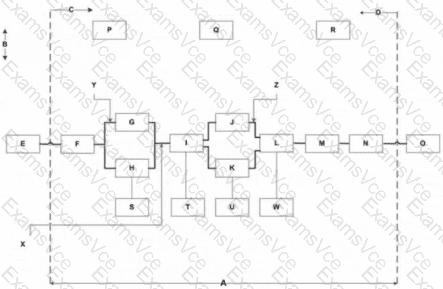The diagram provided is a Function Analysis System Technique (FAST) diagram, a key tool in Value Methodology’s Function Analysis phase, as taught in the VMF 1 course (Core Competency #2). FAST diagrams map the relationships between functions of a system, with the horizontal axis showing the “how-why” logic (critical path) and the vertical axis showing supporting functions. The vertical demarcations on the left and right of a FAST diagram are calledscope lines, which define the boundaries of the study. According to SAVE International’s Value Methodology Standard, “scope lines indicate the limits of the system or project being analyzed, separating the functions within the study’s scope from external functions or assumptions.” This was previously established in Question 15, where scope lines were identified as the correct term for these vertical demarcations.
In the FAST diagram:
The dashed vertical lines on the left and right are labeledB(left) andD(right). These lines define the scope of the study, with functions inside the lines (e.g., E, F, G, J, L, M, N, O) being within the study’s focus, while functions outside (e.g., P, Q, R) are external assumptions or higher-level objectives.
Ais a horizontal line at the bottom, representing the boundary of the diagram but not the scope lines.
Cis an arrow indicating the direction of the “why” axis (left), not a scope line.
Since the question asks for the letter that “represents the scope lines,” and both B and D are scope lines, the correct answer must be one of these. However, the options only allow for one letter to be selected, and in FAST diagramming convention, the left scope line (B) is often emphasized as the primary boundary for defining the study’s starting point (e.g., the higher-order function E, as identified in Question 18). Thus,Bis the most appropriate choice among the options provided.
Option A (A) is incorrect because A is a horizontal line, not a vertical scope line.
Option B (B) is correct, as B is the left vertical scope line, marking the boundary of the study’s scope.
Option C (C) is incorrect because C is an arrow, not a scope line.
Option D (D) is also a scope line (the right boundary), but since only one letter can be selected and B is the left scope line (often the primary focus in FAST diagramming), B is chosen. If the question intended to allow both B and D, the phrasing would need adjustment.
[:, SAVE International, VMF 1 Core Competency #2 (Function Analysis), which includes the use of FAST diagrams and the definition of scope lines as vertical demarcations., SAVE International, “Value Methodology Standard,” section on Function Analysis, describing FAST diagramming conventions, including scope lines as the vertical boundaries of the study., ]


